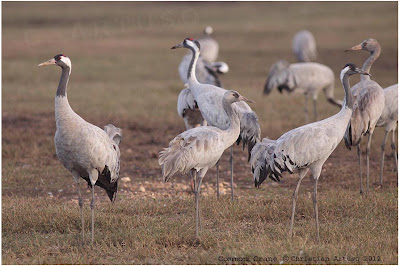The valley once contained the large Lake Hula but this was drained in the 1950s, which created a myriad of problems (as so often happens when we interfere). This area lies on a major flyway and is an important stopover for many thousands of birds so the draining of the lake had wide-reaching consequences for the birds as well as the soil and local human inhabitants (one of the problems when the peat soil was drained was spontaneous fires). In the 1990s, the Jewish National Fund (the very same organization that had drained the lake) recreated a wetland in the Agamon Hula Park, now a major tourist attraction and once again home to thousands of migrating birds, although much smaller than the original lake. This photo shows the Agamon Hula wetland today (the white birds flying in the back are Pied Avocets)
This area was formerly a stopover site from Common Cranes (also known as Eurasian Cranes) migrating between their breeding grounds in northern Eurasia and wintering grounds in Africa. Recently, however, thanks to the wetland restoration work and increasing crane populations elsewhere, the Agamon Hula wetland has become an overwintering site for 30,000 Common Cranes. The cranes have become a major tourist attraction and visitors can enjoy the spectacle of such a large flock from very close quarters in mobile blinds. Here are a few photos of a small portion of the valley’s star flock:
(and here trying to get a little artistically blurry)
And here are a few close-ups of these magnificent birds, a very special treat provided by this unique site!
Note the immature bird in the middle of the following photo...
A portrait of this magnificent animal!
There are many other waterbirds to enjoy watching in the Agamon Hula wetlands, including: Eurasian Spoonbill
Great White Pelican (mostly a passage migrant but a few may overwinter)
Little Egret
Grey Heron
The Pygmy Cormorant has a rather restricted range and this is a great area to see this species (two photos below)
There are also lots of shorebirds (waders) to watch here including the Spur-winged Lapwing (first photo), a species who has probably expanded their range into this area from Africa; Common Snipe (second photo) and Marsh Sandpiper (photo) shown below…
This is a fantastic area for raptor watching too. Here are just a few of the many raptor species that can be observed: Eurasian Marsh Harrier
Greater Spotted Eagle
Long-legged Buzzard coming in for a landing showing their beautiful tail
A most unexpected treat was watching this White-tailed Eagle diving on an Imperial Eagle.
And Black-winged Kite (you might be surprised by this species if you look at range maps but they now breeding in this area)
Other interesting birds to watch around the wetlands include some small brown skulkers such as Moustached Warbler,
Three magnificent kingfishers, including one each of the three major kingfisher groups in the world: representing the small Alcedinid kingfishers, we have the Common Kingfisher (photo below) - Alcenid are the very small colourful kingfishers such as the genera Alcedo and Ceyx)...
Representing the Halcyonid kingfishers (large and mostly colourful kingfishers (though some are more cryptically patterned) in genera such as Halcyon, Todiramphus, Lacedo, etc.and including the so-called forest kingfishers and the kookaburras of Australasia) we have the exquisite and much larger White-throated Kingfisher
And representing the Cerylid kingfishers (who vary in size from very large to quite small and mostly softer and less electrically coloured than other kingfisher groups; generally clad in green, blue and black with whitish or reddish underparts and some with a crested appearance... and, by the way, the only group of kingfishers found in the Americas) we have the Pied Kingfisher (unfortunately I did not manage to photograph on this trip so I am cheating by using this photo from Cameroon)
In the general area, I was treated to several sightings of one of the Old World robins that I am extremely fond of – the Bluethroat (this is a first winter male,; notice for example the bluish malar)
Another beautiful Old World robin is the Black Redstart (Old World redstars are related to Old World robins and not at all related to the birds called redstarts in North America, the latter being wood-warblers)
More open grassy areas and fields hold species such as Crested Lark,
and White Wagtail (and many other species)
Of course, visitors from abroad will be interested in tracking down some of the Middle Eastern regional specialties In treed areas, such as in the kibbutz where we stayed, I tracked down this male Syrian Woodpecker (close relative of Great Spotted Woodpecker)
The regional endemic White-spectacled Bulbul was easy to observe
As was the beautiful Palestine Sunbird. Here are two photos of a male, showing their feeding behaviour and the iridescence that transforms this otherwise black-looking bird into a blast of colour!
Sardinian Warbler is resident in this area and was relatively common.
As is Graceful Prinia
The Rose-ringed Parakeet population probably originates from introduced birds.
It was not a good time of year for owling but I managed to find this Tawny Owl in the kibbutz where we stayed, which put a big smile on my face…
Even though, this was not a birding trip per se, as a testimony to the area’s biodiversity, I managed to observe 119 species of birds in just five and a half winter days. There were some great wildlife sightings too including Golden Jackal and this East European Hedgehog.
But arguably best of all was watching a Jungle Cat stalk and capture a Common Crane. We were not allowed to use flash from the mobile blind so I hade to crank up the ISO and do my best!
Best of all, however, was the opportunity to discuss further partnerships and opportunities to share knowledge!









































Your photos are amazing!
ReplyDeleteThank you Linda!
ReplyDelete